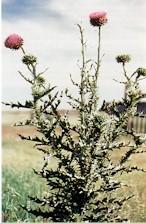Musk Thistle

Overview:
- Musk thistle normally requires two years to complete its life cycle (i.e. biennial or winter annual).
- Occasionally, the plant completes its life cycle in one growing season (i.e. summer annual).
- The typical biennial musk thistle exhibits itself the first year in the from of a rosette, a cluster of tightly packed leaves laying flat on the ground. Rosettes vary in diameter from a few inches to three feet.
- Musk thistle overwinters as a rosette.
- During the rosette stage (either fall or spring) musk thistle is most susceptible to chemical control.
- In its second year of growth, the musk thistle plant will leave the rosette stage as its stem elongates (bolts) toward the mature, flowering plant.
- Chemical control is less effective during the bolted stage and chemical susceptibility continues to decline as the plant reaches maturity.
- The leaves of musk thistle are deeply lobed (segmented), hairless, and are dark green with a light green mid-rib.
- A silver-gray leaf margin is characteristic of each spine-tipped lobe.
- The leaf base extends down the stem to give the plant a winged appearance.
- Musk thistle is the first of the Kansas thistles to bloom in the spring.
- Flowering begins in mid-May and continues through early July.
- Each head consists of many tightly packed rose to purple colored flowers encased in a series of spine-tipped, green bracts.
- The terminal (uppermost) head is 1 1/2 - 3 inches in diameter, solitary, and generally bent over or nodding.
- The mature plant is generally branched, with lower branch producing one or more heads.
- Flowering begins with the terminal head and progresses downward.
- Musk thistle heads are distinguished by their "powder puff" shape.
Information referenced from "MUSK THISTLE A Noxious Weed in Kansas" published by the Kansas State Board of Agriculture Plant Health Division.
